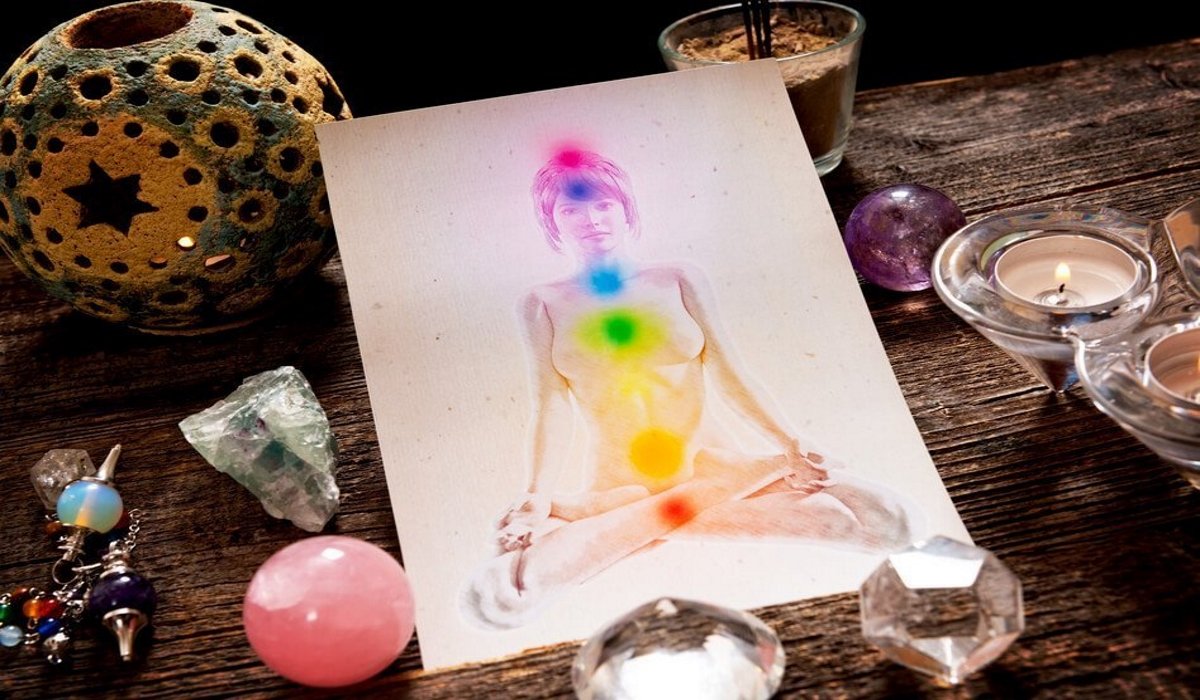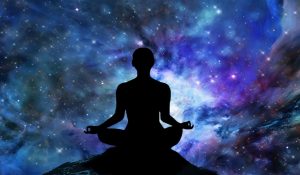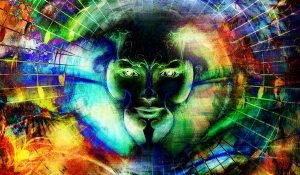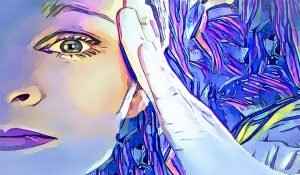In this article, we will talk to you about the seven Chakras. You will learn that the mind is everything, and that what we see is not always all that exists. Understanding the nature of the Chakras is essential to understand deeply how to meditate and to make the most of the energy that resides within us.
What are the 7 chakras

Chakra is a word that comes from Sanskrit, the ancient language spoken by the Indian populations of Asia and also used to compile the oldest texts of their literature, the Vedas. Chakra means wheel, circle, and solar disk, and is an attribute of the Hindu god Vishnu.
According to yoga, in the human being, there are 74 vital points (the chakras, in fact) located between the ethereal body and the carnal envelope, whose activation allows to acquire certain physical abilities, achieve happiness and finally get to awaken the conscience. The Chakras would then be united to different aspects of man (mental, emotional, ethereal…) through a series of channels called Nadis, of the energy highways.
But within this set, there are the 7 basic or main chakras that are distributed from the lower part of the spine, where there is kundalinî (tangled snake energy, which must be awakened) up to the highest part of the head (where if it is developed, what we call halo would appear ). The energy would flow through these channels with ascending and descending movements, while it would form a kind of spiral, spinning like a wheel. Of these seven chakras, the lower and the upper are simple, while the remaining five are composed of a front part and its corresponding back.
What are the chakras for?
And now that you know what the 7 chakras are, you are wondering what they are for: officially the main function of the chakras is to absorb the universal energy, to metabolize it and to feed the different aspects of the human being to finally radiate energy outwards. More simply, we can say that the chakras are energy centers on which different functions depend, not only on the body but also on the psyche.
Below we will describe each of the chakras with some of their most used meanings and characteristics, as well as some psychological and physical illnesses that could be caused by the bad development of each chakra.
1) The Root Chakra or Muladhara

The root chakra is located in the perineum and controls different parts of the body such as the nose, the sense of smell, the lymphatic system, the bone system, the prostate, and the lower extremities. It is usually associated with the color red.
The main consequences of the bad functioning of the root chakra are shyness, feelings of guilt, discomfort, fear of facing life, distrust, distraction, a great dependence on material goods, etc.
You can open this chakra by walking (for example by experimenting with walking meditation), doing aerobic exercises, flexing the trunk to touch the toes of the feet while sitting, doing dance exercises, jumping in place, doing exercises that strengthen your self-confidence, practicing yoga, etc.
Muladhara card
Position: In the perineum between the anus and the genitals, at the base of the spine
Function: Stability, safety, self-confidence
Color: Red
Element: Earth
Sense: Olfactory
Crystals and stones: Ruby, red coral, garnet, jasper, black onyx, oxidania
Mantra: Lam
Note: Do
Animal: Ox, bull, elephant (associated with the earth)
2) The Sacral Chakra or Svadhisthana

The sacral or orange chakra is located in the center of the abdomen and is related to the sexual organs, the reproductive system, and the lumbar plexus.
The consequences of the dysfunction of the splenic chakra are sexual repressions, fear of enjoyment, the contempt of sex and energy blockages that limit the expression of one’s personality.
To activate this chakra you can devote yourself to some exercises such as swimming, taking long baths, showers, a little ‘relaxation in a jacuzzi, or even with dances that involve movements and rotations of the pelvis, closely related to sexual relations.
Svadhisthana card
Position: Lower part of the abdomen
Function: Sexuality, emotions, creativity
Color: Orange
Element: Water
Sense: Tact and taste
Crystals and stones: Amber, citrine, topaz, opal
Mantra: Vam
Note: King
Animals: Crocodile, snake, fish, reptiles
3) The Solar Plexus Chakra or Manipura

The solar plexus chakra is located, as its name says, in the solar plexus (ie the abdominal area just below the diaphragm), is associated with the yellow color and involves different parts of your body such as the skin, the muscular system, the stomach, liver, large intestine and glands and organs at the solar plexus. It is also associated with the eyes, and muscles of the face.
If your solar plexus chakra works badly you could have problems like excess weight in the abdomen, digestive diseases, acidity, ulcers, addiction to stimulants, chronic fatigue, selfishness, personal dissatisfaction, sense of inferiority, sense of guilt, dependence on power, egocentrism, etc.
You can open this chakra by running, unloading tension, changing boring habits, breaking the routine and doing archery exercises, such as the 5 Tibetans.
Manipura card
Location: Solar Plexus
Function: Expansiveness, awareness of life, action, will, and pleasure
Color: Yellow
Element: Fire
Sense: Olfactory
Crystals and Stones: All yellow stones, especially Calcite, Citrine, and Topaz
Mantra: Ram
Note: Mi
Animals: Aries, symbol of fire
4) The Heart Chakra or Anahata

The heart chakra is located at the center of your chest, controlling the heart, circulatory system, lungs, heart plexus, and the entire chest area. The green color is associated with it.
The consequences of the bad functioning of the heart chakra are the inability to love, respiratory and cardiac diseases, selfishness, disconnection, and isolation.
To open this chakra you have to do complete breathing exercises that involve wide pectoral openings, help people every day and set aside hatred.
Anahata card
Position: In the middle of the chest
Function: Love, humility, compassion, generosity, openness to the next
Color: Green
Element: Air
Sense: Touch
Crystals and stones: All green stones, in particular, Tourmaline and Avventurina
Mantra: Yam
Note: Fa
Animal: Antelope
5) The Throat Chakra or Vishuddha

The throat chakra is located at the base of the throat, controlling the neck, throat, hands, and arms. It is associated with the bronchial or cervical plexus and corresponds to the blue color.
A malfunction of this chakra can give rise to problems of voice, throat, vocal cords, communication, malfunction of the thyroid gland and the need to speak a lot, or on the contrary, fear of speaking to avoid problems.
How to activate the throat chakra? With rotations and neck movements, shouting everything you hear in a quiet place, doing vocal exercises, doing singing exercises, pronouncing mantra repetitively and systematically, etc.
Vishuddha card
Position: At the level of the throat, at the cross of the bones of the clavicle
Function: Communication, opening to the next, listening
Color: Blue
Element: Ether
Sense: Hearing
Crystals and stones: All the blue stones, especially the Chalcedony and the Sodalite
Mantra: Ham
Note: Sol
Animal: Elephant
6) The Third Eye Chakra or Ajna

This purple chakra with the mystic name is located at the center of the forehead and is associated with the temples, the carotid plexus and obviously the forehead.
The malfunctioning of this chakra could cause you hallucinations, psychological problems, vision problems, frequent headaches and states of mental confusion.
Read Also: The Pineal Gland (or Third Eye): What it is and Why it is Important to Keep it Active
To activate the third eye chakra you can do guided meditations, visualize simple geometric shapes, massage the temples and the eye contour in a circular way, massage the eyes with the closed eyelids using the fingertips, etc.
Ajna card
Position: At the center of the forehead, between the eyebrows
Function: Intuition, imagination, foresight
Color: Purple or indigo
Element: Light
Sense: Sixth sense
Crystals and stones: Amethyst, fluorite, labradorite, lapis lazuli, moldavite, opal, sodalite, sapphire, zircon
Mantra: Aum
Note: The
Animal: Symbology does not provide a representative animal for this chakra
7) The Crown Chakra or Sahasrara

The crown chakra sits on top of your head, just like a crown, and controls the top of the head, the nervous system, and the brain. It is associated with the purple color.
Problems with this chakra can cause the need to dominate and manipulate others to get what you want, the fact of wanting to always be right, the arrogance, the rigidity in the form of thinking, a high ego, materialistic values, the difficulty in concentrating, the difficulty of thinking independently.
You can activate the crown chakra with meditation and prayer exercises, you can also try to keep your mind free from thoughts for at least 20 minutes with the help of a mantra and sitting upright.
Sahasrara card
Position: At the top of the garment
Function: Universal Awareness or Pure Awareness
Color: Purple and White
Element: Metal
Sense: Empathy
Crystals and Stones: Hyaline Quartz, Amethyst, Diamond
Mantra: Om
Note: Yes
Animal: None
Now that you have learned what the 7 chakras are for and what their functions are, notice the signs your body sends you. Often, a pain or discomfort at a certain point in the body is associated with the chakra that governs it and can be resolved by applying the advice we gave you in this guide.
Knowing the chakras is extremely useful for preserving your physical and spiritual health, and also for better understanding your body and the energies related to it.
If you liked this article, leave a comment and share it with your friends!
Recommended Book for You:
Learn chakra balancing techniques so you’ll be able to heal your chakras into perfect alignment and attract wealth and abundance into your life.









